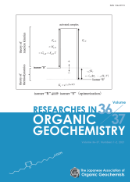A short surface sediment core (40cm) was collected from a strongly acidic (pH=2.2) freshwater lake, Katanuma, Miyagi Prefecture, Japan. Lake Katanuma is a maar, the water of which is rich in sulfate, sulfides and free sulfur and is located in the active Naruko geothermal field. Lipid compounds in the uppermost sediment were extracted and analyzed for organosulfur compounds (OSCs) by gas chromatography (GC) and gas chromatograph-mass spectrometry (GC-MS). The OSCs identified in the lake sediment were C13-C20 3-methyl- and 3-ethyl-5-alkyl thiophenes, C35 hopanoid thiophenes and C18 thiophene carboxylic acids (TCAs), in addition to C20 isoprenoid thiophenes. In the present work, production of C18 TCAs was examined by a mild laboratory simulation reaction of reagent grade linoleic acid (cis, cis-9,12-octadecadienoic acid: C18:2) as well as the solvent extracts from the lake sediments, in H2S saturated water. We confirmed that the C18 TCAs could be in fact produced under the simple experimental system. However, the abundances of the C18 TCAs detected were too small compared with those of possible precursors, C18:2 acids, which is ubiquitous in the particulate matter in the Lake Katanuma water, but almost completely disappeared in subsurface sediment. This finding suggests that sulfur plays a role in a very early stage of diagenesis for sequestering chemically reactive lipid molecules by transforming them into complex geopolymers rather than into small OSCs. No apparent variations in concentration of those OSCs were observed downwards the sediment core. The immediate precursors of alkylthiophenes and hopanoid thiophenes remain to be unraveled.
抄録全体を表示
